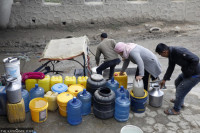Money
Nepse ends higher in volatile trade
In what could be described as one of the most volatile weeks, the domestic capital market witnessed massive fluctuations last week.
In what could be described as one of the most volatile weeks, the domestic capital market witnessed massive fluctuations last week.
Amid planned probe into illicit funds pouring into the stock market, the market saw panicked investors succumbing to selling pressure in the initial days. The market, however, started to recover later in the week after the Securities Board of Nepal (Sebon) scrapped the study team.
Amid continuous fall in the benchmark Nepse index, investors went into panic-selling mode on Monday which resulted in the index shedding 88 points, the record single-day fall. On the day, investors incurred a loss of RsRs98billion as they rushed to sell their stocks amid planned probe into illicit money.
The same day, Deputy Prime Minister and Finance Minister Krishna Bahadur Mahara summoned Sebon Chairman Rewat Bahadur Karki to express his concern.
However on Tuesday, after Sebon scrapped the study team it had formed to probe into possible inflow of illicit funds in the market, the market witnessed a sudden surge, prompting the exchange to impose circuit breaker within the first trading hour. As the week’s trading ended on Thursday, the market seemed to heading towards normalisation. On Sunday this week, the market might see the investors adopting a wait-and-see mode as many have yet to recover from the losses suffered last week, analysts said. However, commercial banks are set to post high amount of trading as talks of dividend distribution will influence investors’ decision, they said.
The massive fluctuation in the stock market over talks about black money suggests there might in fact be the flow of illicit funds, an official of the Nepal Rastra Bank said.
Nepal Stock Exchange (Nepse), driven particularly commercial banks, gained 10.15 points during the week to settle at 1774.84.
Stockbrokers said the regulator’s moves caused such volatile movements. After Monday, the Nepse gained momentum and ending its eight-day losing streak.
Good financial results of commercial banks have been attributed to the rise in their share prices. Out of 28 commercial banks, 21 have published their financial reports and have posted an average net profit growth of around 68 percent in the last fiscal year.
Of the nine trading groups, five posted gains. The insurance sector (up 91.63) led the gainers’ side, while the hydropower group (down 13.01) lost most.
The sensitive index which measures the performance of Class “A” companies went up by 2.59 points.
The secondary market lost Rs98billion on Monday, but recouped the losses on Tuesday and rose throughout the week before losing 4.70 points on the last trading day.
“The market witnessed volatility as new investors panicked amid repeated comments from regulators,” said Anjan Raj Poudyal, managing director of Thrive Brokerage. “The market was largely driven by commercial banks as investors have diverted investments from micro-finances and insurance companies.”
Commercial banks topped the charts in terms of the highest turnover last week. Nepal Bangladesh Bank posted the highest turnover of Rs475.2 million, followed by Nepal Bank, Siddhartha Bank, Everest Bank and Siddhartha Bank.
According to Poudyal, the banking sector has posted good financial reports in the fourth quarter and the investors expect them to distribute good dividends. “The market is going through its normal cycle and as soon as banks distribute dividends and hold annual meetings, a correction can be expected.”
However, the total transaction volume fell by 22.28 percent to Rs6.5 billion during the review period. A total of 107 million shares changed hands in 31,402 transactions.




 8.12°C Kathmandu
8.12°C Kathmandu














